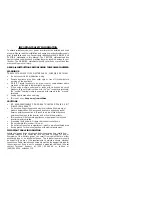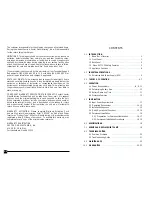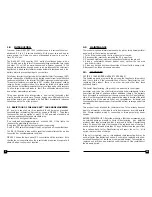
The 110 VAC output of the inverter is in the form of a modified sine wave
(MSW) as shown in
FIGURE 5
. This type of waveform has the same energy
characteristics as the sine wave of commercial electrical power. The modi-
fied sine wave is superior to the 100% square wave output (not shown)
produced by most other DC-to-AC inverters on the market.
A modified sine wave, as compared to a square wave, is vital to the effi-
cient and proper operation of certain appliances such as computers, TVs,
and certain electronic equipment.
Figure 5
– Modified Square Wave and Sine Wave Comparison
NOTE:
The 110 VAC output is a modified sine wave that produces 115 V
AC Voltage. Because of wave-shape differences, if you measure the output
of the inverter using standard digital or analog voltmeters, these instru-
ments may not correctly read the voltage. Unless a true RMS reading
voltmeter such as a
"Fluke 87"
,
"Fluke 8060A"
,
"Beckman 4410"
or
"Triplet
4200"
is used, the reading will be from 2 to 20 volts low.
3. Using the set of heavy-duty jumper cables, attach one red cable clamp
to the (+) terminal bolt and one black cable clamp on the (–) terminal bolt.
4. Connect the clamps on the other ends of the jumper cables to the
corresponding positive (+) and negative (–) terminals on the12-volt DC
vehicle battery. There may be some minor sparking observed.
5. Turn the inverter power switch ON.
6. Plug in a lamp with a 100-watt light bulb and switch the lamp ON. If
the lamp works normally, the inverter is functioning properly and you
can proceed to a permanent installation or continue to use the inverter
with low wattage appliances. If the lamp does not light or does not
work correctly:
A. Check all connections and tighten any loose connections.
B. Ensure that the source battery has adequate charge.
C. If steps A through B do not correct the problem, contact Vector
Customer Service Department (954) 584-4446 ext. 119 for
professional direction.
NOTE
: Any appliance or tool used for this type of test or emergency
operation must be designed for 110 VAC (115-VAC RMS), 60-Hertz (Hz)
and have a power consumption of 600 watts or less. The jumper cables
are not designed for operating the inverter at full power. They are too long
and the voltage drop is excessive.
5.5 PERMANENT INSTALLATION
5.5.1 PREPARATION FOR PERMANENT INSTALLATION
For permanent installation to heavy-duty battery power you will need:
• Ring terminals to fit cable ends and stud terminals
• Hardware to connect two #4 AWG cables to the battery bank
• A single length of not more than four feet of #4 AWG
multi-stranded, flexible, insulated cable
• A 200 ampere low voltage fuse holder and fuse (slow blow type
or use an ANL-200) fuse and appropriate fuse holder
• Mounting screws, bolts and nuts for mounting the inverter and the
fuse holder
• Tools to drill holes for mounting the inverter and fuse holder
• Lead-tin solder, flux, propane torch and an igniter for the torch
• Sharp utility knife to cut insulation and wire
• Battery connector for #4 AWG cable for connection to battery
or batteries
• For permanent installation over four feet use the following gauge
wire, #1 AWG 10 feet, #2 AWG 8 feet, #3 AWG 6 feet
INSTALLATION NOTES:
The inverter has four slots in its mounting bracket that allow the unit to be
fastened against a bulkhead, floor, wall or other flat surface. Ideally, the
mounting surface should be cool to the touch. It is more electrically efficient
to use longer AC wiring than DC wiring, so install the inverter as close as
possible to the 12 VDC power source.
16
7














